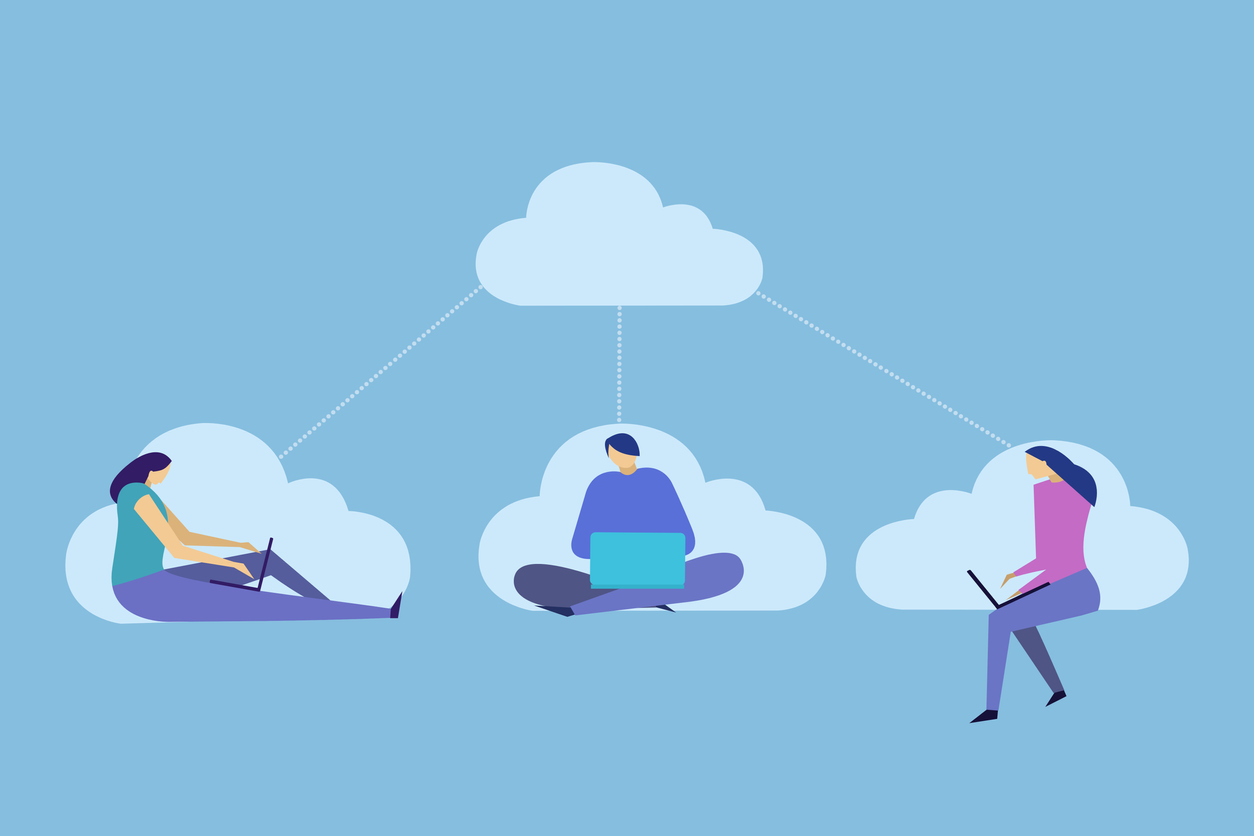Recently the Telecom Reseller podcast invited Vyopta’s Kamalina Czerniak on to talk about the two-track, or bimodal, approach to working, unified communications and UCaaS that large organizations have taken since the beginning of the Covid-19 pandemic. Here’s her talk with TR publisher Doug Green.
Doug: We’re going to be talking about something I think that’s on everyone’s mind. We’re going to be talking about what the world is going to be looking like especially with UandC, UCaaS so on as we start to look at the end of the pandemic, from the possible changes, from the way people are working, maybe working from home, maybe going back to the office, maybe a mix of both, maybe even something completely new. So I really want to thank you for joining me today to discuss these things. But first, what is Vyopta?
Kamalina: Vyopta is a monitoring and analytic software company. We essentially provide monitoring analytics around collaboration technologies, whether that involves unified communications and meeting platforms that are in the cloud or on premises. But also we provide some intelligence around workspaces and how workspaces are used.
So it seems to me that how you described Vyopta puts you right at the center front row seat to the way things are going to be rolling out over the next little bit here, especially in terms of how companies and people inside of the company collaborate, communicate and work together.
Yes, Vyopta has a number of very different kinds of customers in different industries, ranging from distance learning to health care to enterprises all over the world. So you’ve been right there with them from the beginning and seen how Covid impacted their way of working and eventually the type of collaboration that and how their employees were engaging with a different collaboration technologies. And as the pandemic has continued, we’ve we’ve been right there with them essentially generating insights and helping them to understand how that’s changing, and helping them to understand not only how virtual work can be made into something more permanent, how they need to plan for that going forward, but also how they need to start looking at different types of data or data points to make intelligent decisions about how to go back into the office as well.
So how do you see that playing out? What does your research show?
There’s research in the industry and the whole thing around the vaccinations and how those are progressing. And now the latest data are saying that there will be vaccinations that will be made at mass quantities for the population of the vaccine around June, July timeframe of 2021. But the reality is that what happened at the beginning of this year of 2020 was the pandemic hit quite suddenly and people change their way of working to be remote very suddenly.
There’s a huge proportion of people out there who that has worked for in favor in terms of giving them more flexibility, in terms of how they manage their life, in terms of how they manage their work along with their home life. And having that flexibility means that there are many people who don’t want to go back to the way things were before. And so what we’re going to see moving forward is, well, there are a lot of industries and job and people who do want to get back into the office.
What we’re seeing is that around 73 percent of employees are still concerned that being in the workplace today is going to pose a risk to their personal health and safety. And many have come out of this pandemic and realize that they can actually be quite productive working from home. So what we’re going to see is two ways of working, what I like to call kind of a bimodal way of working that’s going to happen and continue into 2021 and possibly permanently to the future.
How does that fit in with certain industries, let’s say health care or education?
With health care in particular telehealth has become quite a common change that’s occurred in the industry where people are able to kind of get their virtual calls as opposed to going to the doctor and putting their own health at risk or necessarily taking a lot of time to drive out of their way and go to his appointments.
As a result telehealth and health care providers have gotten used to providing those services, investing in technology to help them manage that surge in demand for their telehealth services and really starting to think more about the quality of those services as well so that patients and providers can have good experiences. And that’s something that people have gotten used to as well. And I don’t think we’re going to see go anywhere in the future. On the distance learning side, education has changed drastically as well with the amount of classes that some organizations are now managing remotely and essentially. We’re seeing a mix of different types of learning, synchronous learning, where that learning is happening in live, classes led by the instructor has become very common. And in higher education especially, it’s not something that we think is going to disappear anytime soon.
What about other industries?
Well, when we talk about enterprises as a whole, this bimodal way of working is going to be here to stay in the long term. So even as the vaccine comes into place and as a number of people do return to the office, companies are really going to need to think about how they continue to support virtual work in the future and how do they make that sustainable over the long term.
And to do that, it really is going to involve not only making sure they have enough licenses to handle the surge in virtual meeting platform users and licenses that they need the capacity itself of the technology. But also they’re going to want to invest in things like quality and performance management to really understand that people are having good experiences when people are working remotely. One of the challenges is that you get this scenario where it’s very often bring your own device.
And so that becomes harder to manage, harder to standardize in terms of all the things that could go wrong or contribute to kind of a less than ideal experience. So that virtual piece is still important. But then as we see people kind of return to the office, understanding how those spaces are used, how much capacity versus occupancy is in those spaces, are the spaces the right size?
Are people engaging with the right technologies? Understanding, all of that is going to be very important to sustain a good back-to-work plan, a good return-to-office plan at enterprises that span anything from finance to technology to consumer goods. We’re talking corporate offices for a lot of these different types of companies. And the reality is that even as we start to see people trickle back into office, even in the beginning, some of those attendees may not all be joining meetings in the same rooms or in the same conference rooms.
There will be people who will always be joining virtually whether it’s from home or even other parts of the offices. So sustaining this kind of bimodal way of working and having, you know, I.T. teams, technology teams and beyond, thinking about how to manage these two ways of working is going to be really critical moving forward.
How do you see Vyopta fitting in? How are you going to be helping your clients and customers walk through 2021?
That’s a great question, Doug. So when we’ve looked at the virtual work side, one of the things that we’ve seen is that UCaaS usage, UC usage in general surged a lot, over 500 percent at the beginning of the pandemic. And out of many of the companies out there relied on UCaaS technologies and cloud-cased technologies, to build remote work. And what’s happened is many of the companies, around 64 percent, are already using more than on technology from different vendors in their environment.
So being able to manage performance and provide analytics around multi vendor systems is something that’s not necessarily easy to do if you don’t have a dedicated tool for doing that. And that’s where Vyopta can help. On the workspace side in terms of understanding space as well. That’s another way in which Vyopta is engaging with our customers and enterprises and different organizations everywhere in terms of helping them to gather and understand the data around how their spaces are used.
So 91 percent of companies in a recent survey that we did said that it is really important to have actionable data like space occupancy and space booking details to improve how employees use and reserve work spaces. And this is another way in which Vyopta can help companies in terms of providing that information that divisibility to understand how those spaces are being used, what technology is being used in them, how that translates to the booking behavior of the users and employees who are using those spaces and also what technologies and types of activities they’re doing during those meetings. And whether it is kind of the in-person or the virtual way of working,
Over 77 percent of respondents to our survey have told us that improving video quality to meet these new service level agreements and meeting expectations around quality, because remember in the past, it’s taken some years, but now over this past year, unified communications and meeting quality meetings in general have become critical to business, whereas in the past many organizations criticize it. Nice to have not necessarily something that needed to be perfect. There was more tolerance if calls didn’t have the best quality.
Now people understand that it truly impacts productivity of employees. It impacts things like engagement between sales teams and their customers if only way they can interact is virtual. It impacts how a health care provider engages with their patients and how how often and how much loyalty those patients and customers to different organizations will have and keep coming back to them. So around 77 percent of respondents to our survey recently said that improving video quality of service was really critical to them. An even an even higher percentage actually, 99.7 percent said that quality was critical to how they run their virtual collaboration these days.
We seem to be living in what a lot of people described as the Zoom era. But Zoom does have its limitations, especially with regard to dedicated tools and analytics and so on.
Yes, that’s true. So a lot of the platforms like Zoom, like you mentioned, they do have some basic capabilities around that. But they’re really meeting platforms. They’re not really designed to provide really in-depth quality metrics or analytics around how the platforms are used. And one thing that we’re seeing is that while this past year and years past, IT budgets have changed significantly. The strain on IT has definitely increased and especially on unified communications and admin architects of those technologies. And they have to manage without increasing the size of their teams. Huge amounts of increase in usage of these technologies, huge amounts of increases in number of meeting participants in users in meeting minutes and being able to manage all of that with a team that’s of a certain size and it hasn’t grown in scale to it is not manageable unless there is a dedicated purpose-built platform or approach for doing that.
Another analyst talked about how companies that have adopted specialty tools for administration and performance management have actually seen a 28 percent operational administrative cost savings compared to companies that relied solely on the vendor-provided management capabilities. So that’s a huge thing in terms of cost savings that companies look for purpose-built dedicated tools can achieve. On the other hand just relying on what vendors provide like a Zoom doesn’t really help people or teams be proactive around how to manage quality and understand what could be causing issues in the experience.
And really, the only way to do that is having a true proactive approach that alerts you before a user calls in and says there’s an issue and that doesn’t just serve to troubleshoot after a call issue has occurred. But that helps to identify very specific and also systemic wide issues that could be impacting quality, that could be impacting performance and ultimately hampering the productivity and potential business outcomes that are tied to good collaboration experiences.
And that’s where Vyopa comes in.
Yes, that’s where Vyopa comes in with monitoring analytics around collaboration and being able to provide that proactive insight into the performance of different components within systems of performance that different users are having and with the added capability of being able to tag a lot of the the users who use collaboration technology and devices if they’re still being used in certain industries where people are going in person, we are seeing hardware endpoints will be used as well.
The ability Vyopta provides to tag those users as well as devices provides additional insights that are business relevant. So understanding, for example, if you’re C-level executives or having a good experience and being able to troubleshoot their experiences and treat them with greater importance if it needs to be done, or understanding how the marketing team is collaborating versus the engineering team and what needs they may have or even understanding how things are working differently in different locations and getting insights to understand how remote users are having different experiences than those who are going to be coming in person as offices start to reopen more widely. Having these levels of insight is something that Vyopta can help with and that many companies are depending on to improve their experience. But it goes beyond that as well, because when we come to industries such as learning in education or other use cases like telehealth and health care, it’s also about the analytics that can be provided beyond that, with which vendor tools from companies like Zoom, Microsoft, Cisco, Google don’t necessarily provide.
And then we’re talking about information that school districts and higher education organizations and institutions can, for example, use to, prove and have a record of how many classes were held, how many attendees joined those classes, how they joined, how long they stayed for. And in the education space, for example, having that data can really help to easily provide reports that are then used to request funding for the types of technology that are really needed to continue to sustain distance learning programs going forward.
It’s very similar in telehealth and in health care as well, where you’re having data and analytics to prove that the services were rendered, that the patient and provider did attend a call that also you know how long that call occurred, how long it took place and what the quality was for calls as a whole across the organization or across the telehealth service can be very, very beneficial from the line of business perspective as well to ensure that the business goals and outcomes are being met.
So when we look at the overall picture for the coming year, what does that look like?
Well, over the coming year, I think a lot of the things that we’ve learned this year and that we’ve seen and experienced are going to be here to stay. And that’s really the big takeaway for 2021 and potentially beyond. This bimodal way of working is really the way of the future and that companies need to really think of a strategy to understand how to manage and how to optimize both ways of working so that they can be successful as they’re moving forward.
So Kamalina, with that in mind, where can Vyopta help people do this, planning for the coming year?
Vyopta can help in the sense that we’re providing data on collaboration and on how workspaces are used and that data is critical for companies to be able to intelligently plan for the future and make intelligent, data-driven decisions as to how they need to invest in technology to support these two ways of working and as to how they plan these returns to offices in an efficient manner. So this is one of the this is the main way in which Vyopta can really help and that we’re working with a number of companies to do that.
I want to thank you for joining me today. And it’s been really interesting as we sort of look has what you’re calling it bimodal model and how that might emerge. Where can we learn more about Vyopta?
You can learn more about Vyopta by visiting Vyopta.com, and you can learn more and hear not only from us, but from a number of our customers in different industries and fields how they’ve been coping with the pandemic and the change in how work has been happening and how they used Vyopta and help them do that. Again. I want to thank you and your very interesting conversation about the coming year and how bioptic can help people plan for a very interesting and probably hurt plan for you. Yeah. Thank you so much, Chuck.
It was a pleasure talking to you about this topic. Look forward to doing this again soon. Thank you.
Learn more about the future of remote work an
Chad Swiatecki is a business writer and journalist whose work has appeared in Rolling Stone, Billboard, New York Daily News, Austin Business Journal, Austin American-Statesman and many other print and online publications. He lives in Austin, Texas and is a graduate of Michigan State University. Find him online on LinkedIn.








